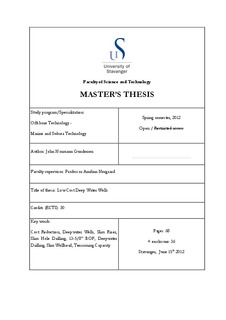| dc.contributor.author | Gundersen, John Normann | |
| dc.date.accessioned | 2012-10-11T13:57:50Z | |
| dc.date.available | 2012-10-11T13:57:50Z | |
| dc.date.issued | 2012 | |
| dc.identifier.uri | http://hdl.handle.net/11250/182930 | |
| dc.description | Master's thesis in Offshore Technology | no_NO |
| dc.description.abstract | A major cost-factor of drilling deep water wells today is associated with the high day rates of the larger rigs capable of drilling in such depths. Most subsea completions today are based on the 18-3/4” wellheads system. This wellhead size is normally required because of the number of casing strings needed to reach the down-hole target depth. Over the last two decades a number of different technologies have been developed to manage longer sections and to increase the drilling reach, especially in deep water. Some of these technologies are briefly described in this thesis, as well as a suggested alternative from the author. The Slim Wellhead Concept may be used to bring older 3rd or 4th generation rigs into the deep water market, achieving cost savings as well as possibilities to reach new water depths of exploration.
Questions being asked in this thesis:* Is it possible to achieve cost saving in drilling by minor adjustments of technology?
* Is it possible to achieve new water depth records with the rigs and technology already available on the market today?
The conclusion of this thesis is that by using the slim wellhead concept with a 13-5/8” BOP and 16” marine riser can give significant savings in weight and requirement to capacities. With respect to variable deck load it is possible to achieve of up to 50% weight reduction for the BOP and 40% weight reduction for the slim drilling riser, valid for 1500 meters of water depth. The selection of a lighter BOP and a slim riser would give a total reduction of 500 tonnes or more to the deck load. The reductions of weight and requirements to capacities of the rigs can facilitate the use of smaller and less expensive drilling vessels. The overall saving potential for a 1500 meters water depth well is found to be in excess of 40%. This number is based on a combination of lower day rate and shorter overall drilling time.
Additionally, it is demonstrated by extrapolation the present tension capacity on 5th/6th generation rigs will be sufficient to support a 16” marine riser in 4000 meter water depth. | no_NO |
| dc.language.iso | eng | no_NO |
| dc.publisher | University of Stavanger, Norway | no_NO |
| dc.relation.ispartofseries | Masteroppgave/UIS-TN-IKM/2012; | |
| dc.subject | offshore teknologi | no_NO |
| dc.subject | undervannsteknologi | no_NO |
| dc.subject | deepwater wells | no_NO |
| dc.subject | slim riser | no_NO |
| dc.subject | slim hole drilling | no_NO |
| dc.subject | BOP | no_NO |
| dc.subject | slim wellhead | no_NO |
| dc.subject | tensioning capacity | no_NO |
| dc.subject | deepwater drilling | no_NO |
| dc.title | Low cost deep water wells | no_NO |
| dc.type | Master thesis | no_NO |
| dc.subject.nsi | VDP::Technology: 500::Marine technology: 580 | no_NO |
| dc.source.pagenumber | 105 | no_NO |
